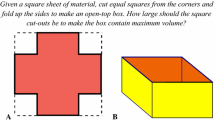Abstract
This article deals with the solving of rotation problems, and shows that there is an alternative to using mental rotations or their encoding into verbal terms: namely using geometrical properties. The idea is consistent with the theory which distinguishes between visual and analytical individuals, but uses the construct strategies instead of the construct preferred processing mode. Moreover, contrary to many researchers who refer to this distinction, but who often use it to classify students, this researcher introduces a new parameter, namely the nature of the task. The article presents the analysis of the functionality and effectiveness of the different kind of strategies as a function of the task's characteristics. The research, dealing not with individual traits but with solving strategies, offers information that could be helpful for the improvement of geometry teaching.
Similar content being viewed by others
REFERENCES
Baldy, R.: 1988, 'De l'espace du dessin à celui de l'objet. Une activité de mises en correspondance entre des dessins en perspective cavalière et des objets réels', Educational Studies in Mathematics 19 (1), 43-57.
BenChaim, D., Lappan, G., Houang, R. T.: 1989, 'Adolescents' ability to communicate spatial information: Analyzing and affecting students' performance' Educational Studies in Mathematics 20, 121-146.
Bishop, A. J.: 1980a, 'Spatial abilities and mathematics education. A review', Educational Studies in Mathematics 11: 257-269.
Bishop, A.J.: 1980b, Spatial and Mathematical Abilities—A Reconciliation, communication presented at 'Conference on Mathematical Abilities at the University of Georgia', Athens, June 12-14, 1980.
Bishop, A. J.: 1983, 'Space and Geometry', in R. Lesh, M. Landau (eds.), Acquisition of Mathematics Concepts and Processes Academic Press Inc., Orlando, Florida, USA, 175-203.
Bishop, A. J.: 1986, 'What are some obstacles to learning geometry, in R. Morris (ed.), Studies in Mathematical Education. Teaching of Geometry, UNESCO, Vol. 5, 141-160.
Bliss, J., Ogborn, J.: 1979, 'The analysis of qualitative data', European Journal of Science Education 1 (4), 427-440.
Bliss, J., Monk, M., Ogborn, J. (eds.): 1983, Qualitative data analysis for Educational Research. A guide to uses of systemic networks, Croom Helm, London and Camberra.
Burden, L. D., Coulson, S. A.: 1981, Processing of Spatial Tasks. M. Ed. Thesis, Monash University, Melbourne.
Clements, K: 1981 Nov, 'Visual imagery and school mathematics. Part I' For the Learning of Mathematics 2(2), 2-9.
Clements, K.: 1982 Mar, 'Visual imagery and school mathematics. Part II' For the Learning ofMathematics 2(3), 33-38. Clements, D.H., Battista, M. T.: 1992, 'Geometry and spatial reasoning', in D. A. Grouws (ed.), Handbook of Research on Mathematics Teaching and Learning. A Project of the National Council of Teachers of Mathematics. Macmillan Publishing Company, New York, pp. 420-464.
Dion, D., Pallascio, R., Papillon, V.: 1985'Typologie des habilités perceptives d'objects polyedriques' Séminaires du CIRADE sur la Représentation, 8 Nov 1985, Centre Interdisciplinaire de Recherches sur lApprentissage et le Development en Education, Université de Québec à Montreal, pp. 107-121.
Eliot, J., Smith, I. M.: 1982, An International Directory of Spatial Tests, NFERNELSON.
Fischbein, E.: 1993, 'The theory of figural concepts', Educational Studies in Mathematics 24(2), 139-162.
Gorgorió, N: 1995, Estratègies, dificultats i errors en els aprenentatges de les habilitats espacials. Tesi Doctoral. Publicacions de la Universitat Autònoma de Barcelona, Universitat Autònoma de Barcelona. ISBN 84490001455.
Gorgorió, N: 1996, 'Choosing a visual strategy: the influence of gender on the solution process of rotation problems', in Proceedings of the 20th Conference of the International Group for the Psychology of Mathematics Education Vol. 3, pp. 19-26.
Guay, R. B., McDaniel, E. D., Angelo, S.: 1978, 'Analytic factor confounding spatial ability measurement', in R. B. Guay and E. D. McDaniel (Eds.), Correlates of Performance on Spatial Aplitude Tests, Purdue University; US Army Research Institute for the Behavioral and Social Sciences, pp. 116-128.
Hershkowitz, R.: 1990, 'Psychological aspects of learning geometry', in P. Nesher, J. Kilpatrick (Eds.), Mathematics and Cognition. A Research Synthesis by the International Group for the Psychology of Mathematics Education, ICMI Study Series, Cambridge University Press, pp. 70-95.
Krutekskii, V. A.: 1976, The Psychology of Mathematical Abilities in Schoolchildren, University of Chicago Press, Chicago.
Lean, G. A., Clements, M. A.: 1981, 'Spatial ability, visual imagery and mathematical performance', Educational Studies in Mathematics 12 (1), 1-33.
Leinhardt, G., Zaslavsky, O., Stein, M. K.: 1990, 'Functions, Graphs, and Graphing: Tasks, Learning, and Teaching', Review of Educational Research, 60(1), 1-64.
Lohman, D. F.: 1979a, 'Spatial Ability: a Review and Reanalysis of the Correlational Literature', Technical Report n. 8 Aptitude Research Project, School of Education, Stanford University, October 1979.
Lohman, D. F.: 1979b 'SpatialAbility: Individual Differences in Speed and level', Technical Report n. 9. Aptitude Research Project, School of Education, Stanford University, October 1979.
Mariotti, M. A.: 1996, The Interaction Between Images and Concepts in Geometrical Reasoning.Unpublished PhD dissertation. Università di Pisa and Tel Aviv University.
Paivio, A.: 1971, Imagery and Verbal Processes, Holt, Rinehart and New York, Winston.
Presmeg, N. C.: 1985, The Role of Visually Mediated Processes in High School Mathematics: A Classroom Investigation, Unpublished PhD Dissertation, University of Cambridge.
Presmeg, N. C. 1986a, 'Visualisation in High School Mathematics', For the Learning of Mathematics 6(3), 42-46.
Presmeg, N. C.: 1986b, 'Visualisation and Mathematical Giftedness', Educational Studies in Mathematics 17(3), 297-311.
Senechal, M.: 1991, 'Visualization and Visual Thinking', in J. Malkevitch (Ed.) Geometry's Future. Conference Proceedings. Comap Inc. Lexington, Massachussets.
Tartre, L. A.: 1990, 'Spatial orientation skill and mathematical problem solving', Journal for Research in Mathematics Education 21(3), 216-229.
Wattanawaha, N.: (1997), Spatial Ability and Sex Differences in Performance on Spatial Tasks M. Ed. Thesis, Monash University, Melbourne.
Author information
Authors and Affiliations
Rights and permissions
About this article
Cite this article
Gorgorió, N. Exploring the Functionality of Visual and Non-Visual Strategies in Solving Rotation Problems. Educational Studies in Mathematics 35, 207–231 (1998). https://doi.org/10.1023/A:1003132603649
Issue Date:
DOI: https://doi.org/10.1023/A:1003132603649




